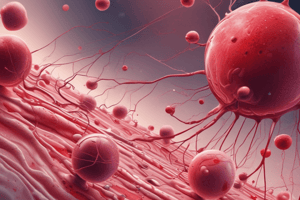Podcast
Questions and Answers
What are the three hemostatic components?
What are the three hemostatic components?
- Anticoagulant Properties, Procoagulation Properties, Fibrinolytic Properties
- Vascular Intima, Platelet, Plasma Coagulation Factors (correct)
- Platelet, Fibrinolytic Properties, Vascular Intima
- Platelet Granule Contents, Plasma Coagulation Factors, Vascular Intima
What are the anticoagulant properties of intact endothelium?
What are the anticoagulant properties of intact endothelium?
- Enhancing fibrin formation
- Activating plasma coagulation factors
- Promoting platelet adhesion and aggregation
- Preventing platelet adhesion and aggregation (correct)
What are the functional characteristics of platelets?
What are the functional characteristics of platelets?
- Fibrin formation, platelet adhesion, plasma coagulation
- Adhesion, activation, aggregation (correct)
- Vascular damage, platelet granule contents, coagulation factors
- Anticoagulant properties, procoagulation properties, fibrinolytic properties
What is the role of coagulation in hemostasis?
What is the role of coagulation in hemostasis?
What are the major hemostatic defects classified under?
What are the major hemostatic defects classified under?
What is the main function of platelets in hemostasis?
What is the main function of platelets in hemostasis?
What is the process of Viscous Metamorphosis?
What is the process of Viscous Metamorphosis?
What is the difference between primary and secondary hemostasis?
What is the difference between primary and secondary hemostasis?
What gives rise to a Common Myeloid Progenitor cell (CMP)?
What gives rise to a Common Myeloid Progenitor cell (CMP)?
What is the defining characteristic of secondary hemostasis?
What is the defining characteristic of secondary hemostasis?
Flashcards
Platelet Function
Platelet Function
Platelets initiate primary hemostasis by forming a weak plug
Primary Hemostasis
Primary Hemostasis
Formation of a platelet plug to stop bleeding
Secondary Hemostasis
Secondary Hemostasis
Formation of stable fibrin clot to seal the wound
Hemostatic Components
Hemostatic Components
Signup and view all the flashcards
Endothelium Anticoagulant
Endothelium Anticoagulant
Signup and view all the flashcards
Coagulation Role
Coagulation Role
Signup and view all the flashcards
Hemostatic Defects Groups
Hemostatic Defects Groups
Signup and view all the flashcards
Viscous Metamorphosis
Viscous Metamorphosis
Signup and view all the flashcards
Common Myeloid Progenitor
Common Myeloid Progenitor
Signup and view all the flashcards
Fibrin Clot
Fibrin Clot
Signup and view all the flashcards
Study Notes
Hemostatic Components
- The three hemostatic components are: blood vessels, platelets, and coagulation factors
Endothelium Properties
- Intact endothelium has anticoagulant properties, preventing clot formation and platelet adhesion
Platelet Characteristics
- Functional characteristics of platelets include: adhesion, aggregation, and release of granules
- Platelets are produced in the bone marrow through megakaryocytopoiesis
- Platelets have a lifespan of 7-10 days and are removed from circulation by the spleen
Coagulation in Hemostasis
- Coagulation plays a crucial role in hemostasis by forming a clot to stop bleeding
- Coagulation involves a complex cascade of reactions involving clotting factors
Hemostatic Defects
- Major hemostatic defects are classified under: vascular defects, platelet defects, and coagulation defects
Platelet Function
- The main function of platelets in hemostasis is to form a platelet plug to stop bleeding
Viscous Metamorphosis
- Viscous metamorphosis is the process by which platelets change shape and become more sticky, allowing them to aggregate and form a platelet plug
Primary and Secondary Hemostasis
- Primary hemostasis refers to the formation of a platelet plug, which is temporary and fragile
- Secondary hemostasis refers to the formation of a stable clot through the deposition of fibrin, which reinforces the platelet plug
- Primary hemostasis is reversible, while secondary hemostasis is irreversible
Common Myeloid Progenitor (CMP) Cell
- A CMP cell gives rise to megakaryocytes, which produce platelets
Secondary Hemostasis
- The defining characteristic of secondary hemostasis is the formation of a stable clot through the deposition of fibrin
Studying That Suits You
Use AI to generate personalized quizzes and flashcards to suit your learning preferences.



